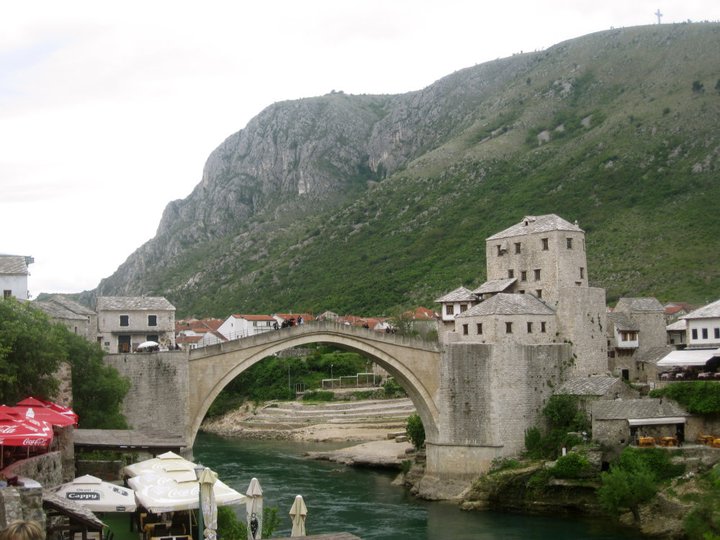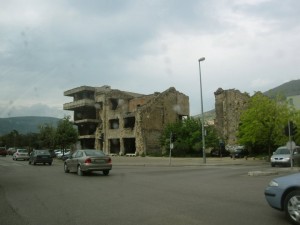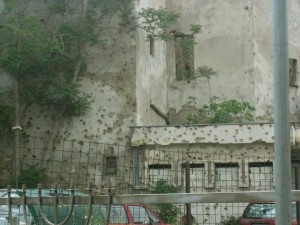“If people cannot find clean water for drinking, wood for shelter and energy and land for crops, what are the chances that peace will be successful and durable?”—David Jensen, United Nations Environment Program (UNEP)
This year, I am a project member of the Bass Connections Team, “Exploring the Intersection of Energy and Peace-building through Film” with faculty advisors Erika Weinthal and Liz Milewicz. Bass Connections is a university-wide initiative that connects students and faculty across academic disciplines through projects that address global and contemporary challenges—such as energy resource management and post-conflict reconstruction. Using post-conflict environmental assessment film footage from the United Nationals Environment Program (UNEP), the project’s goal is to produce visual outreach and training materials for conflict reduction, energy resource management and peace-building.
After a conflict or natural disaster, UNEP conducts field-based assessments of the environmental impacts of the crisis on human health and livelihoods. UNEP assessments are important communication tools that bridge science with the concerns of the local people and policy-makers to ensure that countries recovering from conflict/disaster to “identify the sustainable use of natural resources as a fundamental prerequisite and guiding principle of their reconstruction and recovery.” For example, as part of the project, I cataloged the digitalized video footage of the assessments conducted in Liberia, post-2011 tsunami Japan and Gaza.
UNEP conducted its first assessment report in Kosovo, examining chemical contamination, biodiversity loss and human health impacts after the 1998-1999 conflict. UNEP eventually conducted more assessments in Balkan countries, including a report on the environmental and health impacts of the depleted uranium munitions used by the United States and NATO forces in Bosnia and Herzegovina during the 1992-1995 war after the breakup of Yugoslavia.

Depleted uranium (DU) is a by-product of the uranium enrichment process for use in nuclear weapons. Depleted uranium is chemically toxic and exposure is known to cause adverse health risks such as cancer and congenital disorders. Depleted uranium is used in the armor of tanks and as counter-ballast in aircraft and missiles. According to the UNEP report, exposed fragments, jackets and/or casings of DU weapons are found both lying on the surface and buried at several sites in Bosnia, “leading to the potential contamination of air, soil, water and vegetation from DU residue.”
During the assessment period, UNEP visited 14 sites across the country where DU weapons were suspected to have been used. The report revealed that local ground contamination was usually detected within only one to two meters of localized points of contamination. Secondly, the team found that the mass of DU penetrators had decreased by nearly 25 percent between the end of the conflict and the UNEP assessment period in 2003. Water tests reported that DU contamination was only detected at one site, and air quality tests reported that DU contamination in the air was present at two sites. The report recommends the immediate proper handling and disposal of DU material, annual water and air quality tests, information dissemination to the civilian population and continued scientific monitoring of the contaminated sites.


Although the assessment in Bosnia and Herzegovina reports that it is “highly unlikely” that residue of DU weapons is associated with the reported increase in the risk of cancer, a Harvard University report suggests a linkage between DU and adverse health affects in Iraq. Depleted uranium weapons were first used in warfare by the United States during the 1991 Gulf War in Iraq. It is estimated that 782,141 DU rounds were fired during the conflict. At a Pentagon briefing held in the days before the March 2003 invasion, when asked about Iraq’s health and environmental grievances resulting from the use of DU weapons in 1991, Colonel James Naughton stated that Iraqis, “want it to go away because we kicked the crap out of them.” Despite the concerns for human rights violations and environment/health impacts, it is estimated that the United States fired more than 300,000 DU munitions during the 2003 Iraq War.
Since 2012, 155 nations have supported a resolution to ban DU weapons, while the United States, Israel, the UK and France oppose it. Last October, the United States deployed twelve A-10’s—the type of aircraft that fires DU rounds—to the Middle East, although no DU weapon campaign has been confirmed. Sociologist Craig Considine comments on the hypocrisy of modern chemical warfare by writing, “when ‘non-Westerners’ make use of weapons of mass destruction, there is outrage and calls for military intervention from ‘the West,’ but when ‘Westerners’ themselves use them, it is totally permissible, and the world can hardly react.”

Click here to see how to get involved with Bass Connections.
